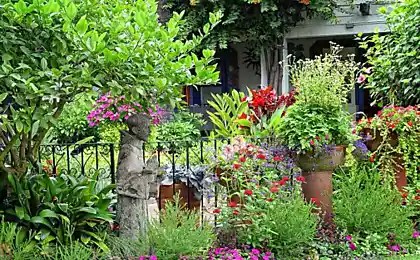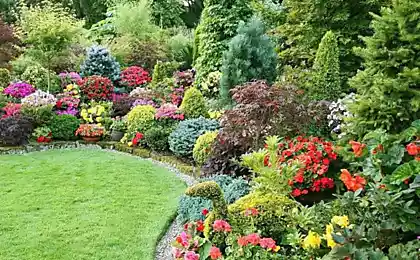287
The best decorative shrubs for giving
Options for the use of decorative shrubs in suburban areas are diverse: hedges, group, single plantings; shrubs can be the background for garden compositions, and their “main characters”. I propose to jointly compile a list of the "most-most" - the most popular, most beautiful, most unpretentious - decorative shrubs for the garden.
My personal hit parade is headed by Spirei. These shrubs from the family of roses are surprisingly undemanding, but very elegant. They are divided into two large groups: spring blooming and summer blooming. Successfully selected spireas will bloom lushly in your garden from the beginning of May to almost mid-summer! But some varieties also have decorative leaves! Details about spirea, care for it, its types and varieties you can read in the article Spirei - the decoration of any garden.
What is good: unpretentious, frost-resistant, lush and long blooms, excellent honey, grows well.
How to use: for laying hedges; in group plantings and shrubbery compositions; compact species (for example, Japanese spirea) are suitable for rockariums and the creation of curbs.
Where to plant: Spirea is undemanding to soils, grows both in the sun and in the penumbra (note that the requirements of different species for illumination and soil moisture may vary slightly).
How to take care of: almost no care.
The delightful aroma of this shrub, also known as garden jasmine (the name is botanically incorrect, but very common), is familiar, probably to everyone. At the time of flowering, the garden literally does not want to leave!
Today, many species and varieties of blackberry are cultivated, differing in the shape of the flower, shades of aroma, the size of the bush and the flowering period. There are even variegated forms (although, to my taste, snow-white blossoms look better against the background of dark green foliage). Details about this plant tells the article Chubushnik - garden "jasmine"
What is good: abundantly blooms, very fragrant, frost-resistant, rarely affected by pests and diseases.
How to use: in single and group plantings, in bush compositions.
Where to plant: preferably in a sunny place, but you can also in the penumbra; fertile soil with good moisture is desirable; peritoneum does not tolerate water stagnation.
How to care: pruning (old branches are cut once every 4-5 years, thickening shoots - annually at the end of summer, dry - every spring); watering in dry weather, fertilizing in spring and autumn.
Kalina Kalina is an amazing plant: beautiful, edible, healing... There are purely decorative species: for example, gordovine kalina (Viburnum lantana) forms inedible fruits, but it has a variety of forms with bright, expressive foliage. And in total, it turns out, the genus Kalin includes more than 200 species, among which there are even evergreen shrubs! Our gardeners have already shared on the site the experience of cultivating kalina of different species: someone grows kalina bulldenezh, someone has kalina evergreen, or lauroleaf, and someone heartily admires kalina ordinary.
In our gardens, it is common kalina that grows most often, the fruits of which serve as valuable medicinal raw materials. Its leaves, changing color from bright green in spring to crimson-red with green streaks in autumn, makes the bush elegant at any time of the year. Details about Kalina, its cultivation and care can be read here in this article.
What is good: frost-resistant, unpretentious, well tolerates shading, decorative throughout the season; the fruits of many species and varieties are edible and healing.
How to use: in single and group plantings, including in combination with other decorative shrubs, as well as trees and conifers.
Where to plant: most species and varieties of kalina are undemanding to growing conditions; prefer well-moistened soils without stagnation of water.
How to care: ordinary kalina is often affected by pests, from which it must be protected, treated with special preparations; otherwise, care consists in regular pruning (removal of dry, old, thickening shoots), mulching of trunk circles, watering in dry weather and spring fertilizing with complex mineral fertilizers.
Rosehip does not need, perhaps, special recommendations - everyone has probably heard about its benefits, and flowers have been admired more than once. In the article Rosehipnik is a useful protector you can read in detail about this wonderful shrub, its cultivation, reproduction, species.
Depending on the species, the “appearance” of rosehip varies, and for your garden it is easy to pick up a plant with those properties that are most valuable to you: someone wants to collect vitamin fruits in the autumn (by the way, you can read about their use in the note Healing Rosehip), someone needs a dense and prickly hedge, and someone needs beautiful flowers... By the way, the terry forms of rose hips, in my opinion, are not inferior to roses.
What is good: extremely unpretentious, easily tolerates transplantation and pruning, grows quickly; many types of rose hips give useful fruits saturated with vitamin C.
How to use: a rosehip hedge will become completely impassable very quickly); this shrub is also suitable for single planting and use in tree shrub compositions.
Where to plant: preferably in a sunny place, but can grow in the penumbra, under the canopy of trees.
How to take care of: almost no care.
Amazing plant: in early spring, forsytia branches are completely strewn with sun-yellow flowers, and only then - when they fall - young foliage appears. This shrub is remarkable, first of all, for its flowering.
The only thing that should be taken into account when buying a seedling: forsytia is thermophilic, and not all of its types are suitable for planting in cold regions - some even freeze when sheltering in harsh winters, and it is impossible to see them in color. More about the features of care, planting and types of this plant will tell the article Golden Forsytsia
What is good: it blooms very early and abundantly, exceptionally decorative during flowering, resistant to diseases.
How to use: looks good in a single planting - on the lawn or surrounded by early flowering bulbs; can be combined with other shrubs in group plantings and used for a hedge.
Where to plant: on light fertile soil; a solar area protected from cold winds is preferred; stagnation of moisture should be excluded, since forsytia does not tolerate overhydration.
How to care: in the winter, the plant is well mulched, and the shoots are bent to the ground so that they are under a layer of snow.
It is difficult to imagine a garden without this plant. Since childhood, I remember gardens and front gardens, in which lilacs rage, and its aroma, which, it seems, you can not breathe. I remember looking in fragrant bunches for "five petals" - flowers with five petals - to make a wish : Then it was more and more ordinary lilac - with lilac-purple flowers in lush brushes.
Now there are many varieties and hybrids of lilac, but still this shrub is loved by gardeners and grows in many in the suburban area. True, in a small garden it is difficult to find a place for such a large plant, but selection here came to the aid of flower lovers: quite compact varieties (up to 2-3 m in height) are bred. Well, more about growing lilac and caring for it will tell this article.
What is good: unpretentious, frost-resistant, has many varieties and hybrids and is surprisingly beautiful at the time of its flowering.
How to use: the lilac bush looks best in a single planting; often this plant is planted near the house (in the front garden) or fence, but in the garden the lilac will be in place.
Where to plant: on a well-lit, sunny area with treated soil; to the composition and fertility of the soil, lilac is undemanding, but does not tolerate wetlands; be sure to leave a large space so that the overgrown bush is not crowded: most lilac varieties are tall and spreading.
How to care: if you prune the faded inflorescences in time, next year the flowering will be more lush; it is recommended every spring to cut out the root growth and unnecessary (too old, dry, thickening, damaged) shoots.
If there is a shady moist corner in the garden, where nothing wants to grow, this is not a cause for distress, but a good opportunity to plant hydrangeas. More information about how to do this, and what care the plant will need later, will tell the article Hydrangea: planting and care
Hydrangea large-leaved and hydrangea blizzard enough frost resistant; under the snow cover they successfully tolerate winter cold. Elegant inflorescences are suitable for cutting: they stand in a vase for a long time. And they can also be dried, suspended in a dry, ventilated room, and used for winter bouquets.
What is good: prolonged flowering, unpretentiousness and the ability to grow on acidic soil, unsuitable for most garden crops.
How to use: in a single planting or in combination with other shade-tolerant shrubs (rhododendron or padub sharp); looks good hydrangea next to hosts, ferns; compact forms of hydrangea large-leaved can be planted on flower beds and flower beds.
Where to plant: in the penumbra, on acidic, well moistened fertile soil; hydrangea prefers wind-protected areas and will feel good on the north side of the house.
How to care: the main care is to maintain constant soil moisture - hydrangea is very moisture-loving; faded inflorescences are trimmed; in the winter in cold regions, shelter is recommended.
The variety of species and varieties of hawthorn allows you to grow it in almost any conditions - up to large tubs on terraces and in winter gardens. In addition to shrubs, there are hawthorn trees. All of them are unpretentious and undemanding, distinguished by abundant, lush flowering in late spring and bright, very decorative color of the foliage in autumn. Many species have medicinal fruits. Read more about Hawthorn here.
What is good: unpretentiousness and decorativeness; the fruits of many types of hawthorn are suitable for processing - confitures and jelly are prepared from them; some types of hawthorn have healing properties, and birds love to settle in the thickets of this shrub.
How to use: mainly in group plantings and hedgerows; tree forms look good one by one; container cultivation of individual species is also practiced.
Where to plant: on a sunny area with loose permeable soil; in order for hawthorn to bloom well and tie fruits, it must be in the sun for at least 6 hours a day.
How to take care of: almost no care.
The name of this shrub is due to the similarity of its leaves with rowan leaves. But he has nothing to do with the ash, but "is related" to the spirea. Rowberry is surprisingly tenacious, unpretentious, grows quickly and is very beautiful at the time of its flowering, which lasts about 3 weeks. But even without flower brushes, the carved foliage of the spreading bush looks attractive, especially in autumn, when it is painted in bright colors. The only drawback - in favorable conditions, the ash tree gives an extensive root growth. If it is not removed in time, it will quickly capture a large space, even make its way to neighbors on the site.
What is good: unpretentiousness, the ability to grow in the shade, beautiful flowering.
How to use: great for decorating garden buildings - a fast-growing mountain hut will hide an unattractive fence and camouflage a shed; can be used in group plantings with other shrubs.
Where to plant: mountain ash can grow both in the open solar area and in the penumbra; it is undemanding to the soil, but it grows better on nutritious loose and well moistened soil; it does not tolerate prolonged drought.
How to care for: the only thing that will require a cowberry is timely and regular removal of the root.
Source: www.7dach.ru
My personal hit parade is headed by Spirei. These shrubs from the family of roses are surprisingly undemanding, but very elegant. They are divided into two large groups: spring blooming and summer blooming. Successfully selected spireas will bloom lushly in your garden from the beginning of May to almost mid-summer! But some varieties also have decorative leaves! Details about spirea, care for it, its types and varieties you can read in the article Spirei - the decoration of any garden.
What is good: unpretentious, frost-resistant, lush and long blooms, excellent honey, grows well.
How to use: for laying hedges; in group plantings and shrubbery compositions; compact species (for example, Japanese spirea) are suitable for rockariums and the creation of curbs.
Where to plant: Spirea is undemanding to soils, grows both in the sun and in the penumbra (note that the requirements of different species for illumination and soil moisture may vary slightly).
How to take care of: almost no care.
The delightful aroma of this shrub, also known as garden jasmine (the name is botanically incorrect, but very common), is familiar, probably to everyone. At the time of flowering, the garden literally does not want to leave!
Today, many species and varieties of blackberry are cultivated, differing in the shape of the flower, shades of aroma, the size of the bush and the flowering period. There are even variegated forms (although, to my taste, snow-white blossoms look better against the background of dark green foliage). Details about this plant tells the article Chubushnik - garden "jasmine"
What is good: abundantly blooms, very fragrant, frost-resistant, rarely affected by pests and diseases.
How to use: in single and group plantings, in bush compositions.
Where to plant: preferably in a sunny place, but you can also in the penumbra; fertile soil with good moisture is desirable; peritoneum does not tolerate water stagnation.
How to care: pruning (old branches are cut once every 4-5 years, thickening shoots - annually at the end of summer, dry - every spring); watering in dry weather, fertilizing in spring and autumn.
Kalina Kalina is an amazing plant: beautiful, edible, healing... There are purely decorative species: for example, gordovine kalina (Viburnum lantana) forms inedible fruits, but it has a variety of forms with bright, expressive foliage. And in total, it turns out, the genus Kalin includes more than 200 species, among which there are even evergreen shrubs! Our gardeners have already shared on the site the experience of cultivating kalina of different species: someone grows kalina bulldenezh, someone has kalina evergreen, or lauroleaf, and someone heartily admires kalina ordinary.
In our gardens, it is common kalina that grows most often, the fruits of which serve as valuable medicinal raw materials. Its leaves, changing color from bright green in spring to crimson-red with green streaks in autumn, makes the bush elegant at any time of the year. Details about Kalina, its cultivation and care can be read here in this article.
What is good: frost-resistant, unpretentious, well tolerates shading, decorative throughout the season; the fruits of many species and varieties are edible and healing.
How to use: in single and group plantings, including in combination with other decorative shrubs, as well as trees and conifers.
Where to plant: most species and varieties of kalina are undemanding to growing conditions; prefer well-moistened soils without stagnation of water.
How to care: ordinary kalina is often affected by pests, from which it must be protected, treated with special preparations; otherwise, care consists in regular pruning (removal of dry, old, thickening shoots), mulching of trunk circles, watering in dry weather and spring fertilizing with complex mineral fertilizers.
Rosehip does not need, perhaps, special recommendations - everyone has probably heard about its benefits, and flowers have been admired more than once. In the article Rosehipnik is a useful protector you can read in detail about this wonderful shrub, its cultivation, reproduction, species.
Depending on the species, the “appearance” of rosehip varies, and for your garden it is easy to pick up a plant with those properties that are most valuable to you: someone wants to collect vitamin fruits in the autumn (by the way, you can read about their use in the note Healing Rosehip), someone needs a dense and prickly hedge, and someone needs beautiful flowers... By the way, the terry forms of rose hips, in my opinion, are not inferior to roses.
What is good: extremely unpretentious, easily tolerates transplantation and pruning, grows quickly; many types of rose hips give useful fruits saturated with vitamin C.
How to use: a rosehip hedge will become completely impassable very quickly); this shrub is also suitable for single planting and use in tree shrub compositions.
Where to plant: preferably in a sunny place, but can grow in the penumbra, under the canopy of trees.
How to take care of: almost no care.
Amazing plant: in early spring, forsytia branches are completely strewn with sun-yellow flowers, and only then - when they fall - young foliage appears. This shrub is remarkable, first of all, for its flowering.
The only thing that should be taken into account when buying a seedling: forsytia is thermophilic, and not all of its types are suitable for planting in cold regions - some even freeze when sheltering in harsh winters, and it is impossible to see them in color. More about the features of care, planting and types of this plant will tell the article Golden Forsytsia
What is good: it blooms very early and abundantly, exceptionally decorative during flowering, resistant to diseases.
How to use: looks good in a single planting - on the lawn or surrounded by early flowering bulbs; can be combined with other shrubs in group plantings and used for a hedge.
Where to plant: on light fertile soil; a solar area protected from cold winds is preferred; stagnation of moisture should be excluded, since forsytia does not tolerate overhydration.
How to care: in the winter, the plant is well mulched, and the shoots are bent to the ground so that they are under a layer of snow.
It is difficult to imagine a garden without this plant. Since childhood, I remember gardens and front gardens, in which lilacs rage, and its aroma, which, it seems, you can not breathe. I remember looking in fragrant bunches for "five petals" - flowers with five petals - to make a wish : Then it was more and more ordinary lilac - with lilac-purple flowers in lush brushes.
Now there are many varieties and hybrids of lilac, but still this shrub is loved by gardeners and grows in many in the suburban area. True, in a small garden it is difficult to find a place for such a large plant, but selection here came to the aid of flower lovers: quite compact varieties (up to 2-3 m in height) are bred. Well, more about growing lilac and caring for it will tell this article.
What is good: unpretentious, frost-resistant, has many varieties and hybrids and is surprisingly beautiful at the time of its flowering.
How to use: the lilac bush looks best in a single planting; often this plant is planted near the house (in the front garden) or fence, but in the garden the lilac will be in place.
Where to plant: on a well-lit, sunny area with treated soil; to the composition and fertility of the soil, lilac is undemanding, but does not tolerate wetlands; be sure to leave a large space so that the overgrown bush is not crowded: most lilac varieties are tall and spreading.
How to care: if you prune the faded inflorescences in time, next year the flowering will be more lush; it is recommended every spring to cut out the root growth and unnecessary (too old, dry, thickening, damaged) shoots.
If there is a shady moist corner in the garden, where nothing wants to grow, this is not a cause for distress, but a good opportunity to plant hydrangeas. More information about how to do this, and what care the plant will need later, will tell the article Hydrangea: planting and care
Hydrangea large-leaved and hydrangea blizzard enough frost resistant; under the snow cover they successfully tolerate winter cold. Elegant inflorescences are suitable for cutting: they stand in a vase for a long time. And they can also be dried, suspended in a dry, ventilated room, and used for winter bouquets.
What is good: prolonged flowering, unpretentiousness and the ability to grow on acidic soil, unsuitable for most garden crops.
How to use: in a single planting or in combination with other shade-tolerant shrubs (rhododendron or padub sharp); looks good hydrangea next to hosts, ferns; compact forms of hydrangea large-leaved can be planted on flower beds and flower beds.
Where to plant: in the penumbra, on acidic, well moistened fertile soil; hydrangea prefers wind-protected areas and will feel good on the north side of the house.
How to care: the main care is to maintain constant soil moisture - hydrangea is very moisture-loving; faded inflorescences are trimmed; in the winter in cold regions, shelter is recommended.
The variety of species and varieties of hawthorn allows you to grow it in almost any conditions - up to large tubs on terraces and in winter gardens. In addition to shrubs, there are hawthorn trees. All of them are unpretentious and undemanding, distinguished by abundant, lush flowering in late spring and bright, very decorative color of the foliage in autumn. Many species have medicinal fruits. Read more about Hawthorn here.
What is good: unpretentiousness and decorativeness; the fruits of many types of hawthorn are suitable for processing - confitures and jelly are prepared from them; some types of hawthorn have healing properties, and birds love to settle in the thickets of this shrub.
How to use: mainly in group plantings and hedgerows; tree forms look good one by one; container cultivation of individual species is also practiced.
Where to plant: on a sunny area with loose permeable soil; in order for hawthorn to bloom well and tie fruits, it must be in the sun for at least 6 hours a day.
How to take care of: almost no care.
The name of this shrub is due to the similarity of its leaves with rowan leaves. But he has nothing to do with the ash, but "is related" to the spirea. Rowberry is surprisingly tenacious, unpretentious, grows quickly and is very beautiful at the time of its flowering, which lasts about 3 weeks. But even without flower brushes, the carved foliage of the spreading bush looks attractive, especially in autumn, when it is painted in bright colors. The only drawback - in favorable conditions, the ash tree gives an extensive root growth. If it is not removed in time, it will quickly capture a large space, even make its way to neighbors on the site.
What is good: unpretentiousness, the ability to grow in the shade, beautiful flowering.
How to use: great for decorating garden buildings - a fast-growing mountain hut will hide an unattractive fence and camouflage a shed; can be used in group plantings with other shrubs.
Where to plant: mountain ash can grow both in the open solar area and in the penumbra; it is undemanding to the soil, but it grows better on nutritious loose and well moistened soil; it does not tolerate prolonged drought.
How to care for: the only thing that will require a cowberry is timely and regular removal of the root.
Source: www.7dach.ru
Archaeologists have discovered in Egypt the remains of the victims of the epidemic
Scientists explained the cause of unpleasant breathing after eating garlic




















